Geotimes

Untitled Document

Feature
Murder and Mud
in the Shenandoah
Megan Sever
Sidebars:
Criminals growing smarter from TV
Sept. 26, 2002
As rain pours down outside of Front Royal, Va., waters in the Shenandoah River
rise. Two men sit in an old black pickup truck at a little gravel boat landing
littered with beer cans and cigarette butts. The dark landing, known as Morgan's
Ford Boat Landing, is a well-known party place for local residents. Around 8:00
p.m., a red Jeep pulls up next to the black truck. As one man gets out of the
truck to greet the Jeep's driver, the window rolls down and a shotgun barrel
pokes out. As the man turns to run, the occupant of the Jeep shoots the man
in the side of the face. As the shot man falls down dead, the driver of the
truck scrambles to leave but is shot in the chest. The Jeep peels out of the
landing, scattering mud and gravel all over.
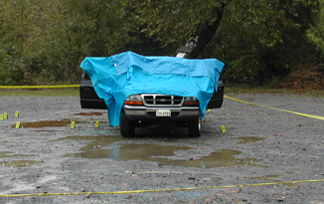 Shortly thereafter,
a local resident sees a body lying in the mud. He calls the police. They arrive
to find a gruesome scene, the likes of which had never been seen in sleepy Front
Royal in the Shenandoah: Blood colors the otherwise muddy ground. One man is
dead, the other is clinging to life.
Shortly thereafter,
a local resident sees a body lying in the mud. He calls the police. They arrive
to find a gruesome scene, the likes of which had never been seen in sleepy Front
Royal in the Shenandoah: Blood colors the otherwise muddy ground. One man is
dead, the other is clinging to life.
Investigators immediately collected soil
samples from the crime scene in Front Royal, Va., to determine who shot and
killed an occupant of this truck and seriously injured another. Photo by James
Cornett.
As the investigators begin to process the scene — taking more than 100
pictures and collecting evidence — they find deep tire marks from where
the assailant had fled. The police conduct background checks on the victims,
and find that they "have drug connections," according to the lead
detective on the case, Lieutenant James Cornett. Days later when the second
victim is able to talk, he reluctantly leads police to a known drug dealer in
Alexandria, Va., 75 miles east of the crime scene.
Not having enough evidence to immediately arrest Lewis William Felts, the suspect,
the Fairfax County police set up surveillance on his townhouse. Seven days later,
police see Felts going to his red Jeep with buckets and rags to wash it. The
police rush in to seize the vehicle to preserve any evidence, such as gunshot
residue and blood spatter. With warrants in hand, the police seize the vehicle
and search it and arrest Felts. The Jeep is transported back to Warren County,
the scene of the crime, to be processed by Cornett.
Investigators do not find blood, but do find gunshot residue and a lot of fresh
mud on an otherwise spotless vehicle. It is enough to make Cornett call an expert,
someone he remembered once speaking about soil analysis at a forensic seminar:
Sergeant Erich Junger of the Fauquier County Sheriff's Office — a forensic
geologist. Cornett hopes Junger's soil expertise can place the vehicle at the
scene of the crime.
The investigators
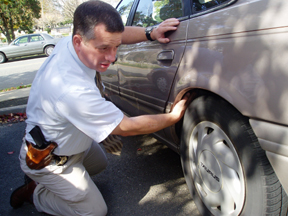 Junger, the son and grandson of geologists,
took a while to get to his current profession. He grew up in Los Angeles, where
he wanted to be a police officer, he says, but when he graduated from high school
in the 1970s, he did not meet the height requirement to join the LAPD. So instead,
he went to college, majoring in medicine, and spent the next 20 years in the
military as a medic. While in the military, he got his master's degree and doctorate
in forensic science, focusing on geology and studying under renowned forensic
geologist Raymond Murray (see story, this issue).
Junger, the son and grandson of geologists,
took a while to get to his current profession. He grew up in Los Angeles, where
he wanted to be a police officer, he says, but when he graduated from high school
in the 1970s, he did not meet the height requirement to join the LAPD. So instead,
he went to college, majoring in medicine, and spent the next 20 years in the
military as a medic. While in the military, he got his master's degree and doctorate
in forensic science, focusing on geology and studying under renowned forensic
geologist Raymond Murray (see story, this issue).
Sgt. Erich Junger of the Fauquier County
Sheriff's Office, a forensic geologist, points out one of the usual places to
look for soil residue to connect a suspect to a crime scene. Wheel wells, insides
of bumpers and the entire undercarriage of the car are likely spots from which
to collect evidence. Photo by Megan Sever.
While working in the forensic pathology laboratory at Walter Reed Army Medical
Center in Washington, D.C., and traveling around the Mid-Atlantic lecturing
to police officers about how to collect forensic evidence, Junger met Cornett.
After retiring from the military, Junger joined the Fauquier County police force
full-time, where he wears three different hats: forensic geologist, crime scene
investigator and deputy sheriff. It's a balancing act, he says, to not blur
the roles (see story, this issue). He is one of a handful
of forensic geologists in the state and in the country for that matter.
Most crime labs and police departments across the country do not have materials
labs (where soils, metals and minerals are analyzed) or forensic geologists
on staff, says Ralph Keaton, executive director of the American Society of Crime
Laboratory Directors/Laboratory Accreditation Board in North Carolina. Usually,
he says, most of the scientists in labs are biologists or chemists. And according
to Bureau of Justice statistics, while 85 percent of the 50 largest labs in
the country have "trace labs," under which soil analysis usually falls,
most of those do not have geologists on staff, Keaton says. Labs are usually
too small and financially strapped to be able to spend the funds on such a specialist,
even if they want to, says Eileen Davis with the Virginia state crime lab.
Instead, most labs send any soil or mineral evidence for analysis to larger
labs such as the FBI laboratory in Quantico, Va., which is the largest of its
kind in the country (see story, this issue). A number of
forensic geologists work there in the physical sciences section.
It's unfortunate that so few labs have forensic geologists, says Chris Palenik,
a postdoctoral geologist with the FBI. "There is a lot of application for
forensic geology in criminal cases, and I think a lot of people don't realize
the value of it," he says.
Indeed, says Jack Crelling, a coal petrologist who teaches forensic geology
at Southern Illinois University in Carbondale, forensic geology encompasses
a wide variety of microscopic analyses, and can help on a number of different
cases. "In our classroom, we cover cases involving sands, soils, fossils,
amber, pollen, coals and carbons, cosmetics, paints, inks, building materials,
isotopes, diatoms and so on." But the largest application of the science,
he says, is using soils to place criminals at a crime scene or tie them to a
victim because of soil transport by foot, clothing or vehicle.
The U.S. Department of Agriculture lists more than 50,000 different varieties
of soil in the United States. And that doesn't even take into account character
or sorting variances among the same soil varieties, Junger says. Soil properties
predominantly result from five factors: parent rock, climate, topography, biological
factors and time. "Dirt 5 feet away might be completely different from
the dirt you're standing on," Junger says.
The diversity of soil characteristics enables geologists to use soils as evidence
in criminal investigations. And that's why Junger, the soil expert, was called
into the Shenandoah murder case.
On the case
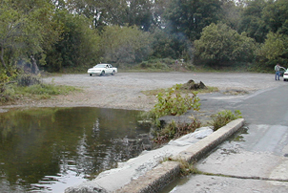 In any forensic
investigation, speed is paramount in evidence collection. That's especially
true in soil-analysis cases, because the soils at the crime scene can change
over short periods of time, according to the FBI’s Handbook of Forensic
Services. For example, it was especially important to sample the Front Royal
site quickly, as "every time it rains, the Shenandoah floods this turnabout,"
Junger says. If not collected immediately, soil samples from the night in question
could have been washed away in the following day or two.
In any forensic
investigation, speed is paramount in evidence collection. That's especially
true in soil-analysis cases, because the soils at the crime scene can change
over short periods of time, according to the FBI’s Handbook of Forensic
Services. For example, it was especially important to sample the Front Royal
site quickly, as "every time it rains, the Shenandoah floods this turnabout,"
Junger says. If not collected immediately, soil samples from the night in question
could have been washed away in the following day or two.
On Sept. 26, 2002, a man was found dead along the Shenandoah River in Front
Royal, Va. Soil samples collected from this boat landing helped place the suspect
at the crime scene. Flares mark where some samples were collected. Photo by
James Cornett.
Throughout the night of the murder and continuing the next day, Cornett collected
soil samples from all of the tire tracks left at the scene, as well as from
sites surrounding the crime scene, including at great distances — for comparison
and to isolate the site where the crime had been committed. He also photographed
and mapped all the places from which he took samples. The samples that Cornett
collected were quite fresh and thorough and "gave us a really good time
shot of what happened and when," Junger says.
After they had the Jeep in custody, Cornett called Junger, who walked him through
evidence collection on the vehicle. Cornett immediately noticed mud splashes
on the back of the vehicle both outside and inside, where "it looked like
mud had splashed into the vehicle somehow," he says. Additionally, the
Jeep had only one layer of mud — "typically you would see depositional
layers in sequential order so you can tell where someone went and when they
came back from the scene," Junger says. This Jeep was otherwise spotless,
Cornett says, so the mud stuck out like a sore thumb. From Cornett's description,
the color and characteristics of the mud on the Jeep made it easy to ascertain
that it came from a watery environment, Junger says. "I knew it was possible
that this vehicle had been at the crime scene," he says.
To collect the soil samples off the Jeep, Cornett first scraped off any big
chunks of mud and put them in pill-bottle-sized jars for safe keeping. "We
want to collect any big clumps intact," Junger says, as they might hold
pebbles or organic matter that are harder to see in smaller samples. Cornett
then wet oversized cotton balls and collected minute amounts of soil off of
various parts of the vehicle — wheel wells, insides of bumpers, suspension
struts and the entire underside of vehicles are usual suspects.
Once all the evidence was "bagged," Cornett drove the samples to the
Fauquier County lab where Junger was waiting.
Slow analysis
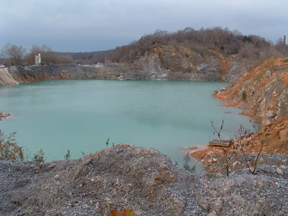 Whereas evidence
needs to be quickly (and accurately) collected, analysis and interpretation
of facts can take much longer, says Palenik of the FBI. "Anyone can put
something under a [scanning electron microscope] and have a technical report
pushed out," as is portrayed in the media, he says, but the true science
of forensics comes from examining the evidence and then deducing a scientific
interpretation.
Whereas evidence
needs to be quickly (and accurately) collected, analysis and interpretation
of facts can take much longer, says Palenik of the FBI. "Anyone can put
something under a [scanning electron microscope] and have a technical report
pushed out," as is portrayed in the media, he says, but the true science
of forensics comes from examining the evidence and then deducing a scientific
interpretation.
Copper, quartz and limestone are mined at a quarry about one-half mile from
the scene of a murder in northern Virginia. Investigators found malachite and
azurite — two minerals that turned the quarry sludge pond teal-colored
— at the crime scene and in samples from the suspect's vehicle. Courtesy
of James Cornett.
Back at the lab, Junger looked at the samples from the crime scene and from
the Jeep under a microscope for uncommon and unusual particles — something
to make the soil distinct. He noticed that the samples from the vehicle matched
the samples from the crime scene in character: Both showed crossbedding effects
from a watery environment, significant rounding and sorting, and the same minerals,
including a "fantastic example" of bright blue- and green-colored
azurite and malachite. Sometimes, he says, geologists can immediately rule out
placement of a suspect at a specific time and place. Other times, it takes further
examination, as was the case here.
Finding the azurite and malachite in the samples from the Jeep and the crime
scene was like hitting the jackpot, Junger says. Usually, "you see the
top 25 most common minerals," so it is the ratio of one mineral to another
or "bizarre stuff in the sample that jumps out at you. The malachite and
azurite sure do that," he says. The minerals are very weak and could not
have traveled far or survived long in the water. He also found quartz, spodumine,
tourmaline and feldspar in the samples.
Junger called Cornett and asked, "is there by chance a quarry anywhere
near the crime scene?" Cornett told him, Junger recalls, that there was
indeed a quarry about one-half mile upstream, where quartz, granite, limestone,
copper and other rocks and minerals are mined.
So, it was off to the quarry for Junger, where the first thing he noticed was
a telltale fluorescent teal pond — and not surprisingly, malachite and
azurite. He moved on to the next downstream landing, which was the crime scene,
and then to another landing about a mile farther downstream where he sampled
the soil; there were no traces of the minerals there. So the scene was set —
the mud on the Jeep, which contained malachite and azurite, matched the mud
at the crime scene.
After further examination, Junger felt he had several facts down: This red Jeep,
which ordinarily was housed in a very clean condition in the city, far from
any soil formations, clearly visited the crime scene around the time of the
crime. He could not place Felts, the suspect, at the scene, but Felts' Jeep
was there, he says, beyond a reasonable doubt. His work was done. He filed the
paperwork and reported his findings to Cornett.
The case builds

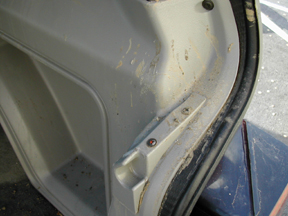 While
Junger was analyzing the soil evidence, Cornett and the Warren County Sheriff's
Office were working on the other details in the case. In Felts' Jeep, they found
a cell phone that had calls from Felts to a phone number that matched a number
in one of the victim's cell phones. The police also traced Felts' calls: Felts
said that he hadn't been to Warren County in years, but phone records showed
that he was in Warren County at the time of the shooting.
While
Junger was analyzing the soil evidence, Cornett and the Warren County Sheriff's
Office were working on the other details in the case. In Felts' Jeep, they found
a cell phone that had calls from Felts to a phone number that matched a number
in one of the victim's cell phones. The police also traced Felts' calls: Felts
said that he hadn't been to Warren County in years, but phone records showed
that he was in Warren County at the time of the shooting.
Far right: A murder suspect's Jeep was spotless, except for the mud found
on the rear of the vehicle that could connect him to the crime scene. Right:
Mud from the rainy crime scene splashed into the back of the suspect’s
Jeep. Courtesy of James Cornett.
Although a gun was never recovered, a witness came forward to tell police that
he sold a shotgun to Felts a month prior to the incident. Police also found
that Felts and the two victims were involved in the distribution of PCP and
crystal meth. According to the police report, the victims and suspect were to
meet at Morgan's Ford Boat Landing on the night of the incident, where Felts
was to supply the victims with 2 ounces of PCP.
The police developed two theories about the motive — the victims were working
for Felts and were stealing from him, or this deadly fight was over a woman.
After his arrest, a grand jury in Warren County found enough evidence to indict
Felts for first-degree murder (a charge that could carry the death penalty in
Virginia), attempted first-degree murder and two counts of use of a firearm
in commission of a felony. Trial motions began in February 2003.
Three months later, on the advice of his court-appointed defense attorney, Felts
pled guilty to all charges against him via an Alford plea on May 16, 2003; basically,
Felts admitted that the state had enough evidence against him that they would
likely convict, but he did not admit fault. It's a way of "saving face,"
Junger says. By pleading guilty, he avoided the death penalty, and the judge
sentenced him to serve life in prison. The judge then suspended all but 25 years
and eight months of the sentence.
Felts now sits in prison. The victim who survived has lost sight in one eye.
Postscript
Had there been a trial, Junger would have been called to testify, as he has
done in at least 100 other cases (probably 20 of which involved soil evidence).
Additionally, the defense would likely have called their own expert soil witness,
such as Murray or Skip Palenik (Chris Palenik’s father), who owns a forensic
analysis company in Illinois, to offer their own interpretation of the soil
evidence.
"As forensic geologists, our job is to stay neutral," Junger says.
"We let the evidence speak for us. Forensic scientists aren't out to testify
for the prosecution or the defense, and it's possible that the facts will point
us in a direction other than toward the police's suspect." Furthermore,
most of the time, he says, "we just provide another piece of evidence —
rarely will it be the key piece that convicts a suspect, but it sure can help
place someone at a scene."
In the Shenandoah case, the soil was the crucial piece for placing the suspect
at the scene. The case was also unusual, Junger says, as murder is not routine
in the small Virginia towns that Junger and Cornett serve. Thus, this case has
stuck with them both. Most of the serious criminal cases in Fauquier County
are related to drugs, Junger says, but are usually property thefts and damages.
In eight years as a Virginia police officer, this is the 12th murder he has
investigated. And as interesting as it was to watch the evidence unfold and
tell the terrible tale, he hopes it is the last.
Criminals
growing smarter from TV
Through crime dramas, the public — including criminals — is getting
a new education on how law enforcement officials collect and analyze evidence.
"These shows are teaching crooks to be smarter," says Sergeant
Erich Junger with the Fauquier County Sheriff's Office in Virginia, "and
that makes our job harder."
For example, Junger says, most hardened criminals wear gloves these days,
because they know from watching crime dramas not to leave behind fingerprints
(see stories linked below, this issue). The dramas
also frequently show where and how to wash a vehicle to make sure mud or
gunshot residue is not found, to always use bleach when trying to clean
up blood evidence, and to put their hair up or in a net so they don't leave
behind DNA evidence.
Of course, Junger says, not all criminals elude investigators. But the other
problems that television dramas create may be even bigger: "The shows
give everyone a false expectation that every case has the same urgency and
importance, can be solved and solved quickly, and all labs have the personnel
and equipment to process all the evidence from a case," Junger says.
"And this just isn't true," says Lieutenant James Cornett of the
Warren County Sheriff's Office in Virginia. These expectations, Cornett
says, can hinder their work. For example, a recent case in Warren County
concerned several mailboxes that had been vandalized. Some homeowners requested
that the police officers visit the sites, take measurements of the mailboxes,
figure out what had hit them — probably a metal baseball bat, Cornett
says — and exactly when, and then send the mailboxes "off to the
lab" for analysis. This is the "type of thing that we just can't
do," Cornett says.
Junger relates a similar story of a woman who stood over him as he collected
evidence from a petty-crime site and said, "aren't you going to collect
all those cigarette butts and test them for DNA like they do on TV?"
There were at least 50 butts on the ground, Junger says, and if he had sent
them to the state lab in Richmond for analysis, it would have taken weeks
to process, not to mention irritated the scientists who were working on
murder cases.
"People have to understand that we have to prioritize cases,"
Junger says. "And they also have to understand that we're not going
to be able to solve everything." On the other hand, he says, "we're
always working to improve our methods and technologies and stay one or two
steps ahead of the criminals. People can't believe everything they see on
TV."
MS
Back to top |
Sever
is a staff writer for Geotimes.
Links:
"Collecting Crime Evidence from Earth,"
Geotimes, January 2005
"A Visit to the FBI Lab," Geotimes, January 2005
"Forensic geology on the small screen,"
Geomedia, Geotimes, January 2005
Back to top
 Shortly thereafter,
a local resident sees a body lying in the mud. He calls the police. They arrive
to find a gruesome scene, the likes of which had never been seen in sleepy Front
Royal in the Shenandoah: Blood colors the otherwise muddy ground. One man is
dead, the other is clinging to life.
Shortly thereafter,
a local resident sees a body lying in the mud. He calls the police. They arrive
to find a gruesome scene, the likes of which had never been seen in sleepy Front
Royal in the Shenandoah: Blood colors the otherwise muddy ground. One man is
dead, the other is clinging to life. Junger, the son and grandson of geologists,
took a while to get to his current profession. He grew up in Los Angeles, where
he wanted to be a police officer, he says, but when he graduated from high school
in the 1970s, he did not meet the height requirement to join the LAPD. So instead,
he went to college, majoring in medicine, and spent the next 20 years in the
military as a medic. While in the military, he got his master's degree and doctorate
in forensic science, focusing on geology and studying under renowned forensic
geologist Raymond Murray (see story, this issue).
Junger, the son and grandson of geologists,
took a while to get to his current profession. He grew up in Los Angeles, where
he wanted to be a police officer, he says, but when he graduated from high school
in the 1970s, he did not meet the height requirement to join the LAPD. So instead,
he went to college, majoring in medicine, and spent the next 20 years in the
military as a medic. While in the military, he got his master's degree and doctorate
in forensic science, focusing on geology and studying under renowned forensic
geologist Raymond Murray (see story, this issue). 
 In any forensic
investigation, speed is paramount in evidence collection. That's especially
true in soil-analysis cases, because the soils at the crime scene can change
over short periods of time, according to the FBI’s Handbook of Forensic
Services. For example, it was especially important to sample the Front Royal
site quickly, as "every time it rains, the Shenandoah floods this turnabout,"
Junger says. If not collected immediately, soil samples from the night in question
could have been washed away in the following day or two.
In any forensic
investigation, speed is paramount in evidence collection. That's especially
true in soil-analysis cases, because the soils at the crime scene can change
over short periods of time, according to the FBI’s Handbook of Forensic
Services. For example, it was especially important to sample the Front Royal
site quickly, as "every time it rains, the Shenandoah floods this turnabout,"
Junger says. If not collected immediately, soil samples from the night in question
could have been washed away in the following day or two.  Whereas evidence
needs to be quickly (and accurately) collected, analysis and interpretation
of facts can take much longer, says Palenik of the FBI. "Anyone can put
something under a [scanning electron microscope] and have a technical report
pushed out," as is portrayed in the media, he says, but the true science
of forensics comes from examining the evidence and then deducing a scientific
interpretation.
Whereas evidence
needs to be quickly (and accurately) collected, analysis and interpretation
of facts can take much longer, says Palenik of the FBI. "Anyone can put
something under a [scanning electron microscope] and have a technical report
pushed out," as is portrayed in the media, he says, but the true science
of forensics comes from examining the evidence and then deducing a scientific
interpretation. 
 While
Junger was analyzing the soil evidence, Cornett and the Warren County Sheriff's
Office were working on the other details in the case. In Felts' Jeep, they found
a cell phone that had calls from Felts to a phone number that matched a number
in one of the victim's cell phones. The police also traced Felts' calls: Felts
said that he hadn't been to Warren County in years, but phone records showed
that he was in Warren County at the time of the shooting.
While
Junger was analyzing the soil evidence, Cornett and the Warren County Sheriff's
Office were working on the other details in the case. In Felts' Jeep, they found
a cell phone that had calls from Felts to a phone number that matched a number
in one of the victim's cell phones. The police also traced Felts' calls: Felts
said that he hadn't been to Warren County in years, but phone records showed
that he was in Warren County at the time of the shooting. 